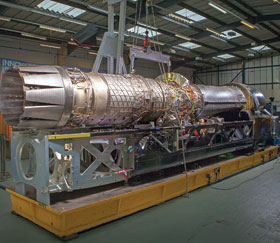

The Bloodhound project is aiming to break the world landspeed record in 2016 on the Hakskeen Pan north of Upington, with the goal of reaching a speed of 1609 km/h. It is the brainchild of Richard Noble, who achieved fame in 1997 with the Thrust Supersonic Car (SSC), when Wing Commander Andy Green broke the world landspeed record for a wheeled vehicle by clocking 1228 km/h at Mach 1.0.
In October the project team achieved a significant milestone in the building of the world’s most powerful racing car when the state-of-the-art EJ200 jet engine was fitted for the first time. Normally found powering a Eurofighter Typhoon, the EJ200 jet engine weighs one ton and produces 90 kN of thrust. A team of five technicians spent eight hours to ensure the jet engine is a perfect fit with the upper and lower chassis and the carbon composite air intake.
In the jet fighter, the EJ200 is designed to be hung from a single mounting point (trunion), so the Bloodhound replicates this. The upper chassis is made of strong but light aluminium to which titanium stringers and titanium skin will be fixed using both glue and 1400 aircraft-spec rivets. The lower chassis below the jet is made of aluminium and steel and houses the Nammo hybrid rocket. The two power plants together produce 210 kN of thrust, the equivalent of 180 F1 cars. The car will cover 16 km in 100 seconds from a standing start, with a 0 to 1600 km/h time of just 42 seconds. At top speed that is four and a half football pitches in one second.
The team also trial fitted the upper chassis ribs over the jet engine to check the fit and clearance of the numerous fuel, electrical and hydraulic systems before the upper chassis is assembled, bonded and riveted.
Earlier this year the cockpit was unveiled. The state-of-the-art carbon fibre monocoque will be Andy Green’s supersonic office during the record attempts in the desert. The structure weighs 200 kg and bolts directly to the metallic rear chassis carrying the jet, rocket and racing car engine. The carbon front section will have to endure peak aerodynamic loads of up to three ton/m² at 1609 km/h as well the considerable forces generated by the front wheels and suspension.
The roof of the cockpit has been designed to create a series of shockwaves that will channel the air into the Eurojet EJ200 jet engine. If supersonic air reaches the jet engine fan blades, the airflow will break down and the engine will choke. This can generate huge changes in pressure that could damage both the jet engine and car, Shockwaves over the canopy will slow the airflow from over 1609 km/h to just 643 km/h in a distance of around one metre.
Deflecting winds travelling five times faster than a hurricane will cause additional noise and vibration to be transmitted into the cockpit. It is positioned in front of three incredibly loud motors: the jet, a cluster of hybrid rockets and the racing car engine that drives the rocket’s oxidiser pump. Collectively they will generate a noise level estimated at 140 decibels. Much of the noise will be directed backwards, away from the driver, and above 1207 km/h the car will out-run its own sound waves. However, the project’s engineers still anticipate that shockwave and jet intake noise levels may produce over 120 decibels inside the cockpit.
Good ergonomics are vital for the dashboard and cockpit given that Bloodhound SSC will cover 1,6 km in 3,6 seconds. The central screen shows the speed and Mach number plus jet engine and rocket outputs. Dynamic speed indicators help Green to judge when to fire the rocket and deploy the braking systems. Wheel loads are also given prominence. Bloodhound does not use aerodynamic downforce, as a Formula 1 car does, while lift at the nose or rear axle must also be avoided at all costs. The need to carefully balance forces throughout its 1609 km/h speed range is one of the major reasons why shaping the car has taken 30 design-years.
The Bloodhound SSC has pedals like a regular car. The right-hand pedal throttles the EJ200 jet engine and will be used to start the car moving. The left pedal controls the wheel brakes and will be used to slow the car at speeds below 321 km/h. The wheel brakes will only contribute about one percent of the total braking effort, reducing the stopping distance by around 800 metres. Braking speed is critical, as using the wheel brakes above 321 km/h will exceed their energy capacity and set fire to them.
For more information visit www.bloodhoundssc.com
© Technews Publishing (Pty) Ltd | All Rights Reserved